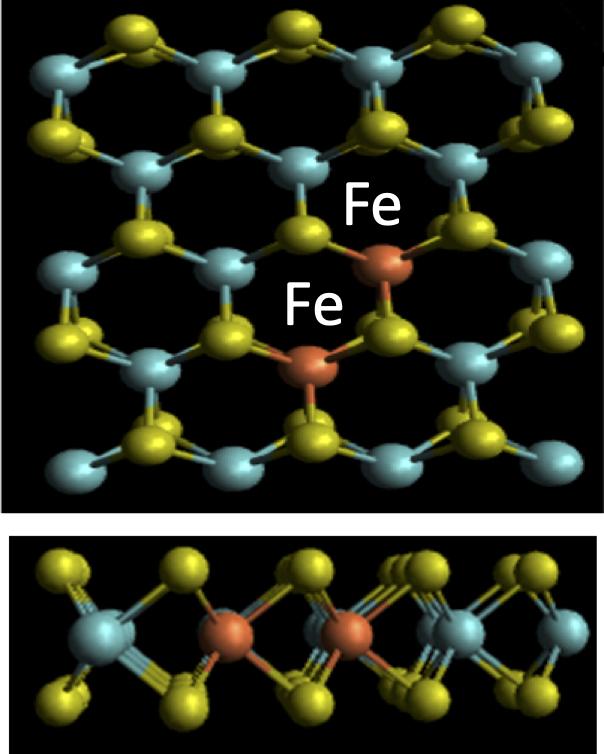Atomically thin magnets for next generation spin and quantum electronics

A ferromagnetic semiconductor semiconductor two-atoms thick. The green, blue, and red spheres are sulfur, molybdenum and iron atoms, respectively. Credit: Stevens Institute of Technology
As our smartphones, laptops, and computers get smaller and faster, so do the transistors inside them that control the flow of electricity and store information. But traditional transistors can only shrink so much.
Now, researchers at Stevens Institute of Technology have developed a new atomically thin magnetic semiconductor that will allow the development of new transistors that work in a completely different way; they not only can harness an electron's charge but also the power of its spin, providing an alternative path to creating ever smaller and faster electronics.
Rather than relying on making smaller and smaller electrical components, the new discovery, reported in the April 2020 issue of Nature Communications, potentially provides a critical platform for advancing the field of spintronics (spin + electronics), a fundamentally new way to operate electronics and a much-needed alternative to continued miniaturization of standard electronic devices.
In addition to removing the miniaturization barrier, the new atomically thin magnet can also enable faster processing speed, less energy consumption and increased storage capacity.
“A two-dimensional ferromagnetic semiconductor is a material in which ferromagnetism and semiconducting properties coexist in one, and since our material works at room temperature, it allows us to readily integrate it with the well-established semiconductor technology,” said EH Yang, a professor of mechanical engineering at Stevens Institute of Technology, who led this project.
“The magnetic field strength in this material is 0.5 mT; while such weak magnetic field strength cannot allow us to pick up a paper clip, it is large enough to alter the spin of electrons, which can be utilized for quantum bits applications,” said Stefan Strauf, a professor of physics at Stevens.
When computers were first built, they filled an entire room, but now they can fit in your back pocket. The reason for this is Moore's law, which suggests that every two years, the number of transistors that fit on a computer chip will double, effectively doubling a gadget's speed and capability. But transistors can only become so small before the electrical signals that they are supposed to control no longer obey their commands.
While most forecasters expect Moore's law will end by 2025, alternative approaches, which do not rely on physical scaling, have been investigated. Manipulating the spin of electrons, instead of relying solely on their charge, may provide a solution in the future.
Building a new magnetic semiconductor using two-dimensional materials – that is, two-atoms thick- will allow the development of a transistor to control electricity with control of the spin of an electron, either up or down, while the whole device remains lightweight, flexible and transparent.
Using a method called in situ substitutional doping, Yang and his team successfully synthesized a magnetic semiconductor whereby a molybdenum disulfide crystal is substitutionally doped with isolated iron atoms. During this process, the iron atoms kick off some of the molybdenum atoms and take their place, in the exact spot, creating a transparent and flexible magnetic material – again, only two-atoms thick. The material is found to remain magnetized at room temperature, and since it is a semiconductor, it can directly be integrated into the existing architecture of electronic devices in the future.
Yang and his team at Stevens worked with several institutions to image the material – atom by atom – to prove that the iron atoms took the place of some of the molybdenum atoms. These institutions included the University of Rochester, Rensselaer Polytechnic Institute, Brookhaven National Laboratory, and Columbia University.
“To do something great in science, you need to get others to collaborate with you,” said Shichen Fu, a Ph.D. student in mechanical engineering at Stevens. “This time, we brought all the right people together – labs with different strengths and different perspectives – to make this happen.”
Media Contact
All latest news from the category: Physics and Astronomy
This area deals with the fundamental laws and building blocks of nature and how they interact, the properties and the behavior of matter, and research into space and time and their structures.
innovations-report provides in-depth reports and articles on subjects such as astrophysics, laser technologies, nuclear, quantum, particle and solid-state physics, nanotechnologies, planetary research and findings (Mars, Venus) and developments related to the Hubble Telescope.
Newest articles

First-of-its-kind study uses remote sensing to monitor plastic debris in rivers and lakes
Remote sensing creates a cost-effective solution to monitoring plastic pollution. A first-of-its-kind study from researchers at the University of Minnesota Twin Cities shows how remote sensing can help monitor and…

Laser-based artificial neuron mimics nerve cell functions at lightning speed
With a processing speed a billion times faster than nature, chip-based laser neuron could help advance AI tasks such as pattern recognition and sequence prediction. Researchers have developed a laser-based…

Optimising the processing of plastic waste
Just one look in the yellow bin reveals a colourful jumble of different types of plastic. However, the purer and more uniform plastic waste is, the easier it is to…


